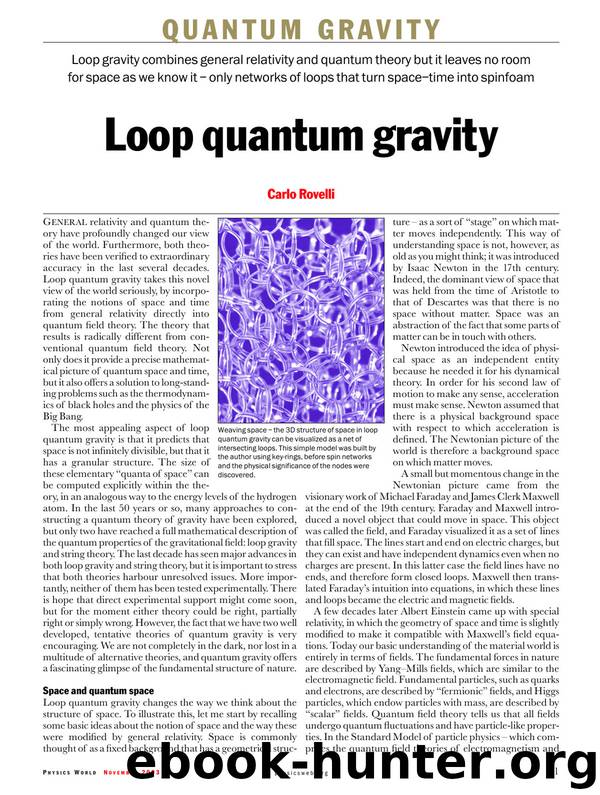Loop Quantum Gravity by Carlo Rovelli

Author:Carlo Rovelli [Rovelli, Carlo]
Language: eng
Format: epub
Published: 2011-02-17T05:00:00+00:00
Q U A N T U M G R A V I T Y
This entropy, S, is given by the famous Bekenstein–Hawking 3 Spinfoam
formula, S = Ak B c 3/4 hෆ G, where A is the area of the black hole l
EREZ and k
P
B is Boltzmann’s constant. A long-standing problem in p
j
A
n
quantum gravity was to understand the temperature of black o
s
k
q
m
holes from first principles, and this formula has now been derived using loop gravity, albeit once a free parameter called n
s
the Immirzi parameter has been fixed.
m
l
Martin Bojowald at the Albert Einstein Institute in Berlin j
p
has recently been able to apply loop gravity to describe the o
q
k
physics of the Big Bang singularity. In cosmology the volume j
l
of the expanding universe plays the role of the time parame-time
k
ter. Since volume is quantized in loop gravity, the evolution of l
the universe takes place in discrete time intervals. The idea j
that cosmological time consists of elementary steps changes the behaviour of the universe drastically at very small scale, k
and gets rid of the initial Big Bang singularity. Bojowald has Loop quantum gravity replaces the Newtonian concept of background space also found that an inflationary expansion might have been with a history of spin networks called a spinfoam. Each link in the network is associated with a quantum number of area called “spin”, which is measured driven by quantum-gravitational effects. These developments in units related to the Planck length. Here a θ-shaped spin network (bottom) are exciting, but they are just a taste of the full cosmological with three links carrying spins j, k and l evolves in two steps into a spin implications of loop gravity.
network carrying spins o, p, q, j, k, l, m, n and s (top). The initial spin network The eigenvalues of volume and area are also solid quantita-has two nodes where the three links meet, and the vertical lines from these nodes define the edges of the spinfoam. The first vertex – which is similar to tive predictions of the theory. This means that any volume the vertex of a Feynman diagram – is where the left edge branches off, at and area that we could measure should correspond to a par-which point an intermediate spin network with spins o, p, q, j, k and l is ticular number in a spin network. A direct test of this would formed. The edge on the right branches off in a second interaction vertex, which is enlarged. The “faces” of the spinfoam are the surfaces swept by the require us to measure volumes or areas, such as cross-sections, links moving in time. The enlargement shows that the vertex is connected to with Planck-scale precision. This is currently well beyond our four edges and six faces with associated spins j, k, l, m, n and s. Spinfoams experimental ability, but it is reassuring that the theory makes like this one can be thought of as a discretized quantum space–time.
definite quantitative predictions.
The granular structure of space that is implied by spin net-pendent approach
Download
This site does not store any files on its server. We only index and link to content provided by other sites. Please contact the content providers to delete copyright contents if any and email us, we'll remove relevant links or contents immediately.
Tools of Titans by Timothy Ferriss(8292)
Turbulence by E. J. Noyes(7970)
Secrets of Antigravity Propulsion: Tesla, UFOs, and Classified Aerospace Technology by Ph.D. Paul A. Laviolette(5328)
Astrophysics for People in a Hurry by Neil DeGrasse Tyson(5147)
Room 212 by Kate Stewart(5062)
Design of Trajectory Optimization Approach for Space Maneuver Vehicle Skip Entry Problems by Runqi Chai & Al Savvaris & Antonios Tsourdos & Senchun Chai(5032)
Pale Blue Dot by Carl Sagan(4944)
The David Icke Guide to the Global Conspiracy (and how to end it) by David Icke(4650)
A Journey Through Divination and Astronomy by Publishing Pottermore(4361)
Goodbye Paradise(3757)
Apollo 8 by Jeffrey Kluger(3659)
COSMOS by Carl Sagan(3579)
Losing the Nobel Prize by Brian Keating(3514)
The Five People You Meet in Heaven by Mitch Albom(3512)
How to Read Water: Clues and Patterns from Puddles to the Sea (Natural Navigation) by Tristan Gooley(3426)
Brief Answers to the Big Questions by Stephen Hawking(3387)
How to Read Nature by Tristan Gooley(3286)
The Order of Time by Carlo Rovelli(3159)
A Brief History of Time by Stephen Hawking(2987)
